The main discoveries in space and the important news in 2004
x-prize
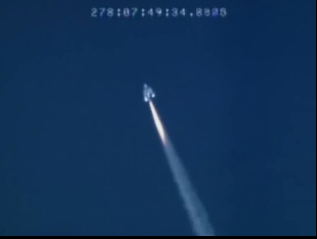
On 4/10 after long months of dramas and upheavals, citizens managed to do the unbelievable and fly into space, at least for five minutes. The private spaceship Spaceship1, built by the Scaled Composite company, flew into space twice in five days, thereby winning a cash prize of ten million dollars.
Spaceship1 recently completed the second flight as part of the attempt to win the prize. The required height was achieved, and Scaled Composite made history by winning the X-Prize. The historic flight was held on the anniversary of the first transatlantic flight from London to New York (1958) and the launch of the Sputnik satellite (1957).
The Scaled Composites company is owned by Brett Rutan - an aviation pioneer, and Paul Allen, one of the founders of Microsoft, and now they have been joined by the owner of the Virgin airline, Richard Branson, who ordered several spacecraft based on Spaceship 1 to fly paid passengers to the brink of space.
Workshop mysteries
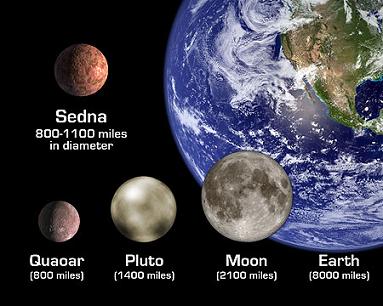
15/3/2004 - The Spitzer Space Telescope discovered a body with a diameter of about 2,000 km moving in a fixed orbit at a distance of about 10 billion km from the Earth. This object belongs to a group known as the Kuiper Belt itself.
The Kuiper belt itself These are bodies in the solar system made of ice and orbiting the sun beyond the orbit of Neptune. Today over 400 such objects are sold. It is estimated that these are remnants from the process of creating the solar system and therefore these are the most primitive bodies that can be studied.
The name of the new body is "Sadana", after the Eskimo goddess of the ocean. NASA will one day provide more details about the discovery, which was also observed by the Hubble Space Telescope.
Observations reveal that the diameter of "Sedna" is about 2000 kilometers, and it may be even larger than Pluto, which has a diameter of 2250 kilometers. This is the largest bone found orbiting the Sun since the discovery of Pluto in 1930. Initial calculations state that it is about 10 billion kilometers from Earth in a region known as the Kuiper Belt, where hundreds of astronomical objects, some of which are composed of rocks and ice, exist. The importance of the discovery of "workshop" is that, unlike those objects, it moves in a fixed path.
A strange prediction of the theory of relativity has been confirmed - the earth drags the space around it (22/10/2004)
One of the last predictions of Albert Einstein's theory of general relativity, which has not yet been proven, has been confirmed by a precise relativity measuring tool, which has calculated how the Earth rotating on its axis crosses the fabric of space in the Space Warp. The experiment was carried out almost for free and was done using ground lasers. A similar study is to be carried out using a $700 million satellite, called Gravity Probe B, launched in April to examine exactly these effects.
What is a space jump?
The 'space jump' in the dictionary is defined as a hypothetical disruption in the space-time continuum, and it may allow passengers to fly faster than the speed of light. It is a consistent result of general relativity, which describes gravity as a curvature in space created by the object sitting inside the gravitational well.
According to general relativity, a mass rotating around an axis will attract the space around it. The effect becomes important to understand cases of fast motion, such as for example swirling pulsars or the motion of gas surrounding black holes. This phenomenon is called 'frame-dragging' or the 'Lance Tearing' effect. It was first predicted by the Austrian physicists Josef Lens and Hans Thiering in 1918, but until then scientists did not have instruments precise enough to measure tiny changes in the fabric of the universe.
Deciphering the Columbia disaster, NASA has not yet resumed flights
Months after the crash of the space shuttle "Columbia", the American space agency (NASA) announced at the end of the week that the cause that led to the crash had finally been determined. This concludes the scientific examination, which began hours after the crash in which the team members perished, including the Israeli Ilan Ramon.
A senior director of the space program, William Reddy, said that the tests show that the malfunction was caused by a problem in the production of the foam that insulates the fuel tanks. According to him, the liquid fuel, whose temperature is extremely low, cooled the air near the foam and turned it into a liquid. The liquid got into tiny spaces inside the foam (that weren't supposed to be there) or accumulated next to it. When the spacecraft was launched and the heat increased, the liquid spread and caused a piece of foam the size of a suitcase to fly out.
NASA believed that the insulation foam "peels off" and falls to the side of the shuttle during launch. However, when the Columbia was launched, the foam did not peel off, but was "shot" at enormous speed towards the left wing of the shuttle while blowing a large hole in the wing. Experiments done in the middle of last year showed that the size of the hole may reach about 60 cm. For this reason, it seems that the piece of foam that broke off from the fuel tank 81 seconds after the launch hit the leading edge of the left wing with force and caused a hole - when it returned to the atmosphere allowed hot gas to enter the body of the shuttle. The gas intrusion caused the wing to fall and the shuttle to disintegrate.
And in spite of everything, it appears that NASA has not yet met all the safety requirements demanded by the investigative committee, and during 2004 not a single shuttle flight took place. Currently talking about May 2005. Not final.
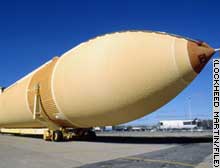 From a new fuel tank to the ferry, December 2004
From a new fuel tank to the ferry, December 2004
The Europeans launched a satellite to a comet. The Americans are on their way
After two postponements, the European Space Agency (ESA) launched the "Rosetta" satellite into space on 2/3/04. An Ariane 5 missile took off this morning at 07:17 GMT (09:17 Israel time) and despite the unflattering record of this missile in previous launches, this time the launch went without a hitch.
The launch was supposed to take place already last week, but was postponed twice. The first time it was rejected due to strong winds in the upper layers of the atmosphere and the second time due to a problem discovered in the insulation foam. This morning, the satellite was successfully launched.
And as the song goes, Anything You Can Do, I Can Do Better, on January 12 from Cape Canaveral and you'll arrive at Comet Temple 1 six months later. The mothership will release a 360-kilogram projectile called an "impactor" directly into the path of Temple 1. The projectile will hit the comet on July 4, 24 hours after its release.
Hawking regrets (25/5)
For many researchers this was the ultimate challenge: the attempt to formulate a mathematical equation that would describe, at least in principle, everything in the universe. But it seems that the "theory of everything" will always remain beyond the reach of man. Stephen Hawking, who claimed in his book "A Brief History of Time" that science is on the verge of formulating such a theory, changed his mind. We may have to accept that we will never understand all the mysteries of the universe, he says now.
If scientists knew the location and speed of all the particles in the universe and the physical laws that govern them, they could - given a sufficiently powerful computer - calculate the state of the universe for all its components, at any given time. The power of such a system of equations will be so great that its knowledge will be the knowledge of God's will, stated Prof. Hawking in a widely publicized statement.
According to astronomer Martin Rees, a "theory of everything" has long been considered improbable. Hawking's decision to abandon the pursuit of such a theory was given without considerable detail in an article he published online. In the article, "Gedel and the end of physics", he describes how the classical ideas of the mathematician Kurt Gedel make the "theory of everything" impossible.
The fight for the Hubble Space Telescope
The Hubble Space Telescope was at the center of a public fight this year. At the beginning of the year, NASA said that the manned service flight to Hubble was canceled, a decision that will limit the lifespan of the telescope. One of the most vocal defenders of the decision was NASA Administrator Sean O'Keefe. O'Keeffe, who announced his retirement in December, fears for the fate of the astronauts who will be sent to maintain the telescope on the space shuttle, and who will not be able to use the facilities on the International Space Station to check the shuttle's health before it returns to Earth. All professional committees, including those advising Congress, rejected this claim and said that a flight to Hubble could be made while leaving another shuttle on standby. That decision now rests with NASA's next administrator, though the year astronaut training ceased
In preparation for the promotion, it will not be possible to reply.
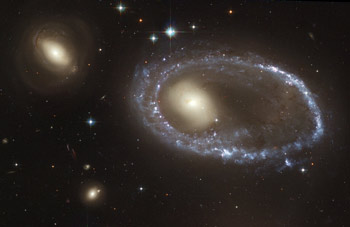
To conclude this year, we have chosen one of the most beautiful images taken by the telescope. Hubble recently observed a bright circle of bright blue stars in a rare example of a "ring galaxy" the result of a collision between galaxies. The galaxy is larger than our Milky Way and is far away in the direction of the southern Dorado system. The image was released for publication on the occasion of the 14th birthday of Hubble's operations in space. The galaxy, whose catalog number is AM 0644-741 is a prime example of a ring galaxy. Ring galaxies are formed as a result of a galaxy collision that dramatically changes the structure of the galaxies involved in the collision and also spurs the formation of new stars.
Returning to the moon
35 years after the landing of the first astronauts on the moon, a hesitant phase is beginning to return to interest in our cosmic neighbor. The Smart-1 spacecraft began orbiting in the last two months, after making the short journey from Earth in 14 months. The reason is that it is driven by an ion engine, but for the European Space Agency, which proved its endurance in Rosetta's 10-year journey to a comet, 14 months is small money.
space guard
Just yesterday, on the penultimate day of the year, the concern that an asteroid discovered this year might crash into Earth on April 13, 2029, was removed. The space watchers have been hard at work and published several "almosts" of this type throughout the year. Meanwhile we didn't need an asteroid half a kilometer in diameter to create huge tsunami waves like the ones that caused this week's disaster in Southeast Asia.
The aliens were wirelessly silent despite ten years of listening
31/3
Astronomers have recently completed one of the most sensitive searches for radio signals from intelligent civilizations in space. They believe that the best way to find ET is to look for radio signals capable of traveling enormous distances.
The radio telescope in Arecibo, Puerto Rico, along with Jordall Bank in the UK have been searching for such signals for the past ten years. The scientists examined each and every one of the 800 nearest stars to us but found no evidence of a radio signal from ET. They say they learned a lot, and they are planning more searches next year.
Mars
The most important site from which reports have been received this year is the planet Mars. Two NASA vehicles - Spirit and Opportunity - landed at two opposite points on its equator and began to explore their surroundings. These environments - in the Gosev Crater and the Meridian Plain - are very different from each other, but both vehicles managed to find remains of materials that, at least on Earth, are known to be formed in the presence of water. It is estimated that a shallow sea covered these areas and perhaps large parts of Mars in general.
Even though these vehicles were allotted 90 Madiman days (a Madiman day is about half an hour longer than the Earthly one), they are still alive and working, and one of them, the Spirit, even shows an improvement in performance because some natural factor was responsible for removing the dust from the solar collectors that provide the energy consumption of the robotic vehicle.
The big flops

On September 8, 2004, helicopters with special hooks were waiting in the air to catch the parachute of the Genesis spacecraft that was carrying with it particles that it collected in space from the solar wind. However, these parachutes did not open and the spacecraft crashed in the Utah desert. The cause of the crash - a damaged electric battery.
On September 6, 2004, an attempt to launch the "Ofek 6" photography and intelligence satellite failed. The first two stages of the launch went successfully, the satellite left the launch pad, however, due to a technical failure, it was unable to rise into the air and fell into the Mediterranean Sea. The Ministry of Defense and the aviation industry said that the cause of the malfunction is being investigated. At 13:45, after secret preparations, the launch of the spy satellite took place in Palmachim. The first 2 stages passed successfully but in the third stage the systems failed. This is a blow to Israel's missile defense system.
As a reminder, the year 2004 began with the search for the Beagle-2 spacecraft that crashed on Mars on 26/12/2003.
Israel in space
The Israeli communications satellite Amos 2, launched in December 2003, was a great success. At the beginning of the year, it still made its way to its orbit and today it is already used by the customers of the Space Company to receive TV broadcasts. In the field of self-launching of military observation satellites we were not so successful (see the chapter on the big flops).
China in space
After the record of launching an astronaut who circled the Earth for a day in October 2003, this year was mainly a year of declarations. The Chinese have concentrated on unmanned spacecraft and the training of 14 taikonauts in preparation for launching a pair of astronauts for a mission of several days in October 2005. In the meantime, there is also talk of plans to launch spacecraft, as yet unmanned, to the moon.
Saturn
In the second half of 2004, the eyes are turned to Saturn. The Cassini spacecraft reached it at the beginning of July and since then it has not stopped transmitting interesting findings from the planet itself, its rings and some of its moons that have been revealed in the most detail so far. On January 14th, a European spacecraft, Huygens, which separated from Cassini on December 25th, will land on the land or perhaps the oceans of Saturn's large moon - Titan, which has a compressed atmosphere.
The International Space Station
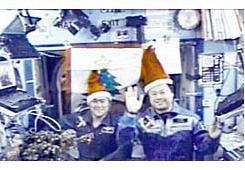
This year, three groups of two astronauts stayed on the International Space Station, because due to the Columbia disaster there is a limit on the amount of food and supplies that can be uploaded to the station. These crews had to deal with oxygen leaks, food shortages and many minor mishaps. And yet they performed spacewalks for the first time to perform necessary work, without leaving anyone inside the station.
